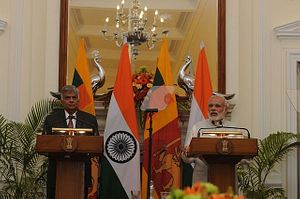India doesn’t seem to value self-criticism, as evident in the sedition charges pressed on the outspoken student leader Kanhaiya Kumar from Jawaharlal Nehru University. Like Kumar, many Indians who have criticized their country have been branded “anti-nationals.” It is perhaps because of the same threat that Indian media have avoided stories about the country’s reputation in South Asia.
As Indians travel to Bhutan and Nepal, their first observation is the influence of India’s entertainment industry and popularity of Indian products. As they walk the streets, they can hear Bollywood songs and Hindi TV serials playing in homes and shops, which sell items imported from India. But Indians’ pride in their country’s rich culture and strong economy lasts only until they make local friends.
India’s reputation was once described to me by a senior Nepali journalist a few years ago. “No significant political decision is taken by Nepal without India’s ‘permission,’” he told me. The writing is on the wall for any regime or leader that seeks to give more importance to Beijing than New Delhi, I was told. The examples included the fall of the monarchy in 2006 and the resignation of Maoist leader Prachanda as prime minister in 2009, after both sought to cosy up to China.
India is feared even in Bhutan, the only country in the region that has been loyal to New Delhi for decades and the destination of Indian Prime Minister Narendra Modi’s first state visit.
A senior Bhutanese official once told me that his country seeks to look culturally different from India, after I asked him why law in Bhutan requires all citizens to wear the national dress in offices and public functions, and all buildings to follow the traditional architecture. No one should even think that “we are part of India,” he added.
As you step into the Bhutanese border town of Phuntsholing, adjoining the Indian town of Jaigaon in West Bengal, you can tell on sight that you’re in a different country. The official explained that the distinction was deliberate, and not just organic.
This overemphasis on culture has made Bhutan a rare tourist spot, but it also testifies to its deep sense of geopolitical vulnerability.
It can be argued that it is this fear that compels Bhutan to give exclusive influence to India while keeping China at a safe distance. Bhutan’s first prime minister, Jigmi Y. Thinley, sought to test his boundaries by publicly asserting that Bhutan being a sovereign nation had the right not to overlook its relations with its neighbors, including China. Thinley’s defeat in the subsequent national election in 2013 was attributed, of course in whispers, to that “mistake.” For Bhutan’s self-censored media would never criticize India.
India’s South Asian neighbours have been suspicious about India’s foreign policy objectives since the 1970s, thanks to the aggressive interventions of then Prime Minister Indira Gandhi, who helped Bangladesh in its 1971 Liberation War, authorized the detonation of a nuclear device in Pokhran in 1974, allegedly annexed Sikkim in 1975, and was accused of supporting the Tamil Tiger rebels in Sri Lanka in the 1980s, only to later abandon their cause and fight them in a military intervention.
It was particularly Sikkim’s “incorporation” into India that made smaller neighboring nations nervous. For example, Bhutan’s emphasis on cultural preservation by law and its efforts towards cultural uniformity began after Sikkim became part of India. In Bangladesh, the then regime of General Ziaur Rahman began to cultivate closer ties with China and Pakistan to counterbalance New Delhi. In Nepal, people wondered if their country would be the “next Sikkim.”
Decades later, these fears linger among India’s neighbors. And the foreign policy of India’s relentlessly globetrotting prime minister seems to overlook this major, persistent hurdle to India’s efforts to build its soft power. Modi seems focused only on countering China’s influence in the region, as was evident in New Delhi’s recent alleged unofficial blockade on Nepal’s borders, apparently to punish Kathmandu for not listening to India’s advice about constitutional provisions.
However, Modi faces no public pressure to improve India’s image among its immediate neighbors. And why should there be demand when ordinary Indians are not even aware there is a need?
In its 2015 study on the reputation of the world’s 55 largest economies, the research firm Reputation Institute found that while India’s overall global image had improved by 7.4 percent compared from the previous year, India still had the largest gap between its self-image and external perceptions (29.1 points on a scale of 0 to 100) – after only China (47.2) and Russia (31.3). Had such a study been conducted in India’s South Asian neighbors alone, the gap would likely have been much wider.
Whether India wakes up to the need for adjustments to its foreign policy will depend on which side of the “anti-national” debate wins: those who want to continue to bask in a false sense of pride that is constructed mostly on non-negotiable nationalistic narratives or those who believe in introspection and are willing to change.

































